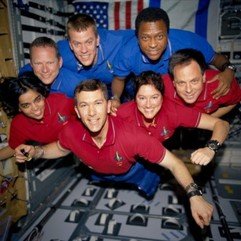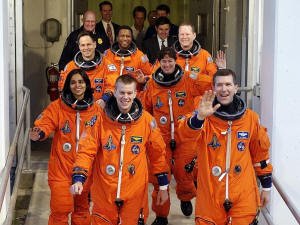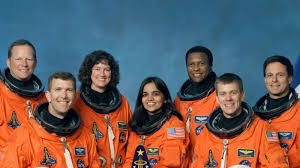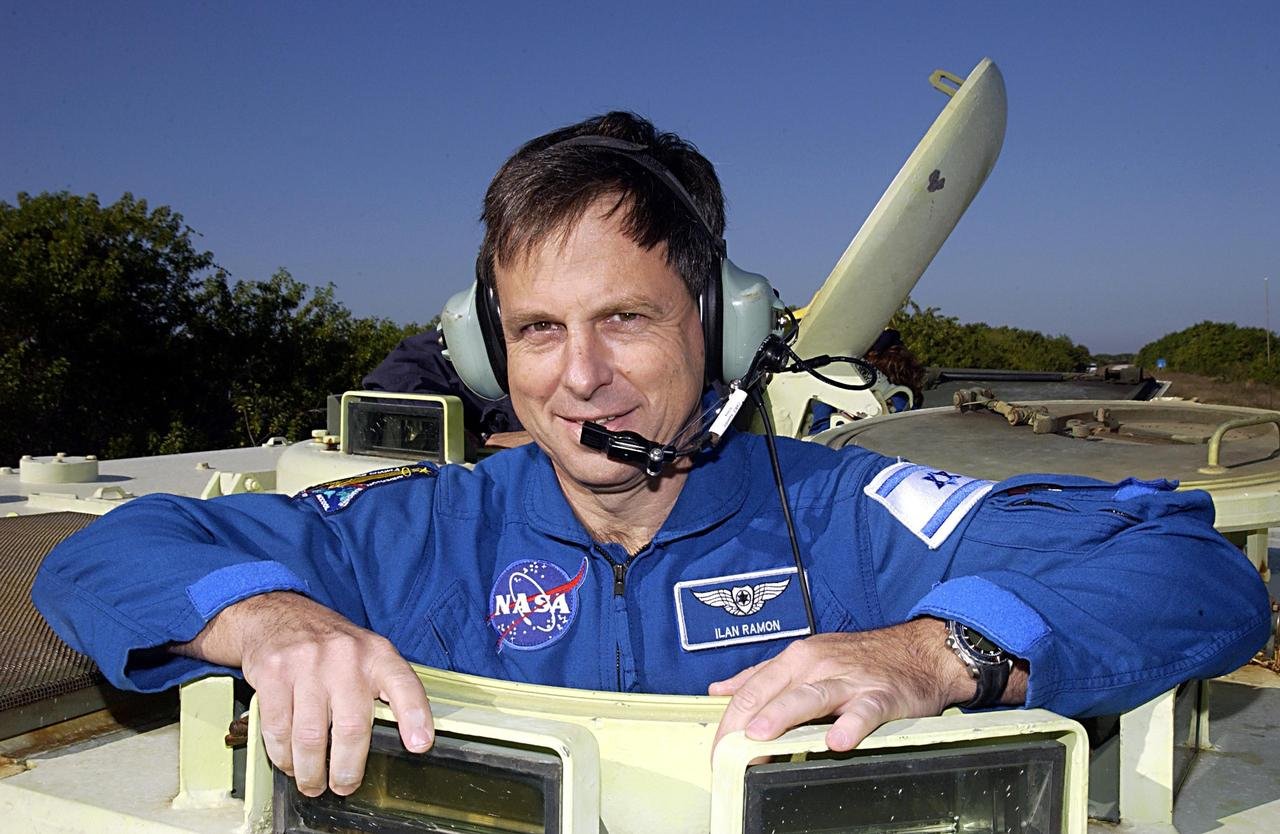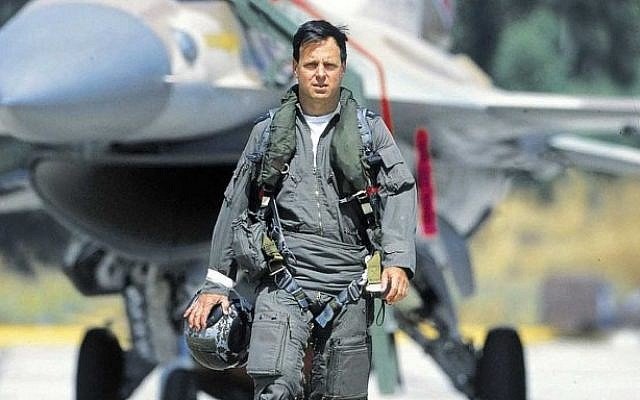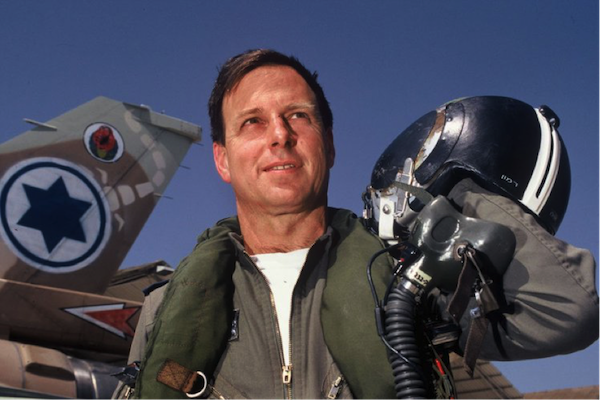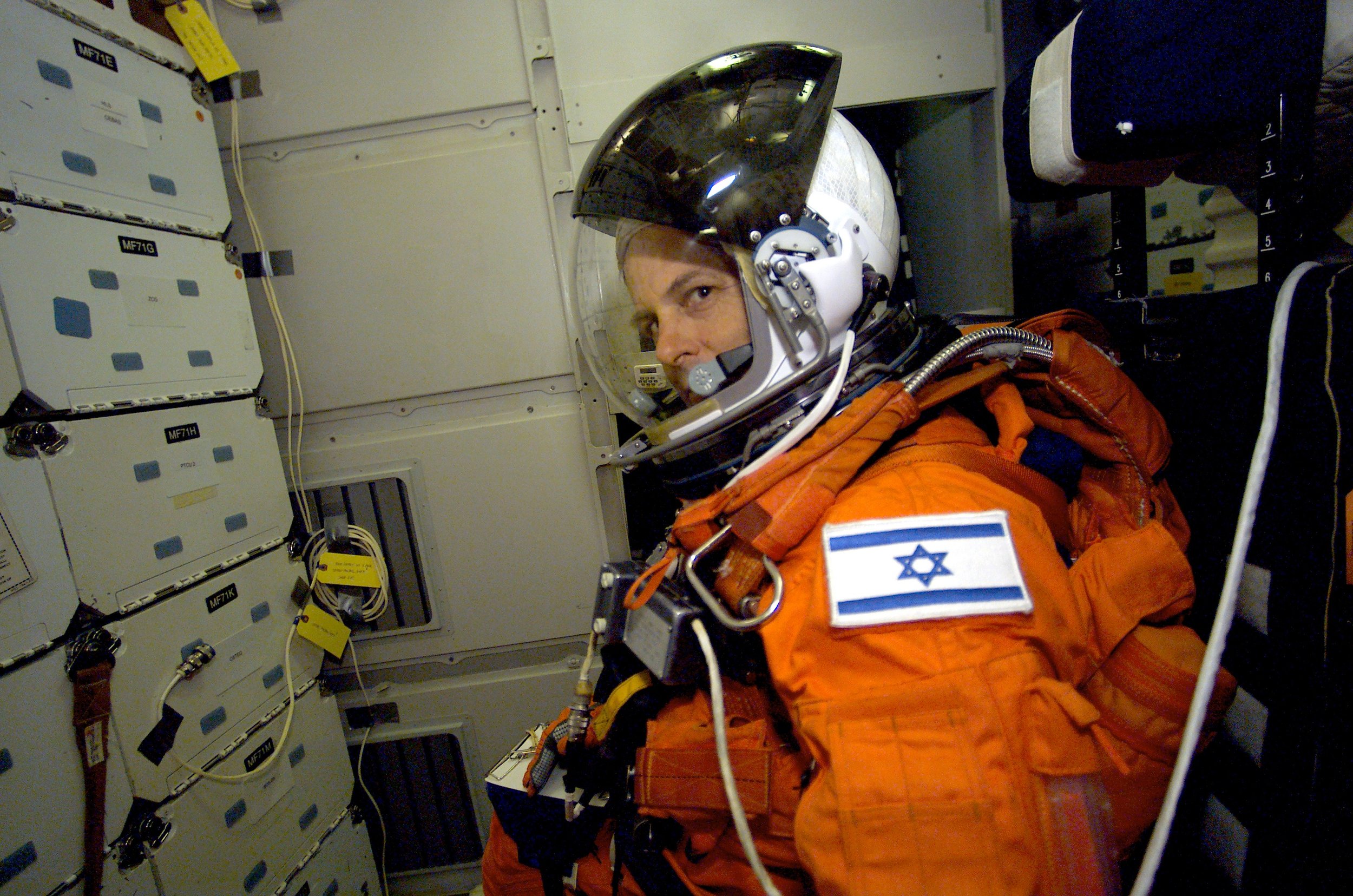Ilan Ramon
Born in Ramat Gan, Israel, to Tonya (1929–2003) and Eliezer Wolfferman (1923–2006), a family of Ashkenazi Jewish descent, Ramon grew up in Beersheba. His father was from Germany, and his family fled Nazi persecution in 1935. His mother and grandmother were from Poland, and were Holocaust survivors, having been in Auschwitz. They emigrated to Israel in 1949.[3] Ramon's first name, Ilan, means "tree" in Hebrew.[4] Ramon Hebraizied his surname from Wolfferman to Ramon, a more "Israeli (Sabra)" name, when he joined the Israeli Air Force (IAF). This was customary and expected of IAF pilots, as well as among IDF senior officers at the time.[5]
Ramon graduated from high school in 1972. In 1987, he graduated with a B.Sc. degree in electronics and computer engineering from Tel Aviv University.[6]
Air Force career
The F-16 Netz 243 flown by Ramon in Operation Opera. The green and black triangular emblem on the nose commemorates the attack.
Ramon was a Colonel (Aluf Mishne) and a fighter pilot in the Israeli Air Force, with thousands of hours of flying experience. He began the fighter pilot's course at the Israeli Air Force Flight Academy in 1972, but was forced to suspend his studies after breaking his hand. Ramon served in an electronic warfare unit in the Sinai during the Yom Kippur War, and afterwards, returned to the flight academy. He graduated from the fighter pilots' course in 1974. From 1974 to 1976, Ramon participated in A-4 Skyhawk Basic Training and Operations. From 1976 to 1980, he participated in training and operations for the Mirage IIIC. In 1980, as one of the IAF's establishment team of the first F-16 Squadron in Israel, Ramon attended the F-16 Training Course at Hill Air Force Base, Utah. From 1981 to 1983, he served as the Deputy Squadron Commander B, F-16 Squadron.[6]
In 1981, Ramon was the youngest pilot taking part in Operation Opera, Israel's strike against Iraq's unfinished Osiraq nuclear reactor. The facility was destroyed, killing ten Iraqi soldiers and one French researcher.[7][8] Ramon also participated in the 1982 Lebanon War.
After attending the Tel Aviv University, Ramon served as Deputy Squadron Commander A, 119 Squadron, flying the F-4 Phantom (1988–1990). In 1990, he attended the Squadron Commanders Course and between 1990 and 1992, commanded 117 Squadron, flying the F-16. From 1992 to 1994, Ramon was head of the Aircraft Branch in the Operations Requirement Department. In 1994, he was promoted to the rank of colonel and assigned as head of the Department of Operational Requirement for Weapon Development and Acquisition. Ramon stayed at this post until 1998.
Ramon accumulated over 3,000 flight hours on the A-4, Mirage IIIC, and F-4, and over 1,000 flight hours on the F-16.[6]
NASA experience
NASA on-ground trainings
In 1997, Ramon was selected as a Payload Specialist. He was designated to train as prime for a space shuttle mission with a payload that included a multispectral camera for recording desert aerosol (dust). In July 1998, Ramon reported for training at the Johnson Space Center in Houston, Texas, where he trained until 2003. Ramon flew aboard STS-107, logging 15 days, 22 hours and 20 minutes in space.
Space flight: STS-107, Space Shuttle Columbia
STS-107 Columbia (January 16 – February 1, 2003), a 16-day flight, was a dedicated science and research mission. Working 24 hours a day, in two alternating shifts, the crew successfully conducted approximately 80 experiments.
Personally nonreligious, Ramon performed traditional observance while in orbit: "I feel I am representing all Jews and all Israelis." He was the first spaceflight participant to request kosher food, and marked the Sabbath.[9]
The STS-107 mission ended abruptly when Space Shuttle Columbia was destroyed and its crew died during re-entry, 16 minutes before scheduled landing.
Ramon, whose mother and grandmother were survivors of Auschwitz, was asked by S. Isaac Mekel, director of development at the American Society for Yad Vashem, to take an item from Yad Vashem aboard STS-107. Ramon carried with him a pencil sketch, Moon Landscape, drawn by 16-year-old Petr Ginz, who was murdered in Auschwitz. Ramon also took with him a microfiche copy of the Torah given to him by Israeli president Moshe Katsav and a miniature Torah scroll (from the Holocaust) that was given to him by Prof. Yehoyachin Yosef, a Bergen Belsen survivor.[10] Ramon asked the 1939 Club, a Holocaust survivor organization in Los Angeles, for a symbol of the Holocaust to take into outer space with him. A barbed wire mezuzah by the San Francisco artist Aimee Golant was selected. Ramon also took with him a dollar of the Lubavitcher Rebbe, Rabbi Menachem M. Schneerson.[11] Ramon and the rest of the Columbia crew died over East Texas in the Southern United States during entry into Earth's atmosphere, 16 minutes prior to scheduled landing.[6]
Diary
Among the recovered 40% from the contents of the Columbia Space Shuttle that crashed outside Palestine, Texas, were 37 pages of Ramon's diary, which NASA returned to his wife.[12][13] His widow, Rona,[12] shared an excerpt with the Israeli public in a display at Jerusalem's Israel Museum.[14] Rona Ramon brought it to Israel Museum forensic experts. Only two pages were displayed, one containing Ramon's notes, and the other is a copy of the Kiddush prayer.[14] Curator Yigal Zalmona[15] said the diary was partially restored in one year, and needed four more, for police scientists to decipher 80% of the text. Zalmona stated: "The diary survived extreme heat in the explosion, extreme atmospheric cold, and then "was attacked by microorganisms and insects. It's almost a miracle that it survived — it's incredible. There is 'no rational explanation' for how it was recovered when most of the shuttle was not, he said."[14] Ramon wrote on the last day of the journal:
Today was the first day that I felt that I am truly living in space. I have become a man who lives and works in space.
Inscribed in black ink and pencil, it covered the first six days of the 16-day mission.[16]
Family
Ramon was survived by his wife, Rona, and their four children: Assaf, Tal, Yiftah, and Noa, who were in Florida at the time of the accident.
Assaf Ramon
Ramon's eldest son, Assaf (February 10, 1988 – September 13, 2009), died at age 21 during a routine training flight while piloting his F-16A, three months after graduating from the IAF flight school Hatzerim Airbase as the top cadet in his class.[17][18][19][20] Assaf lost consciousness during a spell of vertigo, as a result of the high speed and G-force conditions to which he was subjected. This led to the plane crash and Ramon's subsequent death. He was considered an excellent pilot.[21] A lieutenant of the Israeli Air Force, he was posthumously promoted to the rank of captain.[21]
Rona Ramon
Ramon's widow, Rona Ramon, served in the Israel Defense Forces as a paramedic and later earned a BA at the Wingate Institute. After Assaf's death, Rona returned to school and earned a master's degree in holistic health at Massachusetts' Lesley University. She also began to lecture about dealing with grief and finding coping mechanisms. Rona served as founding CEO of the nonprofit Ramon Foundation for youth academic excellence and social leadership through science and technology.[22] She died on December 17, 2018, after battling pancreatic cancer.[23] After her death, she was awarded Israel prize for lifetime achievement.
Tal Ramon
On November 10, 2013, the American Society for Yad Vashem held a special event with the participation of Ramon's son, Tal, who performed a song he wrote in memory of his father.[24] Tal Ramon performed his debut album, Dmut, at the club Zappa Tel Aviv in 2016.[24]
Awards and honors
Military decorations:
Yom Kippur War campaign ribbon (1973)
1982 Lebanon War campaign ribbon (1982)
F-16 1,000 Flight Hours (1992).
Posthumously awarded:
Congressional Space Medal of Honor (Ramon is the only non-U.S. citizen recipient to date)[25]
Namesakes
In Israel
Ramon Airport, named in honor of Ilan and Assaf Ramon[26]
The international Ilan Ramon Conference,[27] hosted by the Israel Space Agency
Ilan Ramon Youth Physics Center, Ben-Gurion University of the Negev, Beersheba
Ramon Control Tower, Ben-Gurion Airport
Ilan Ramon Elementary School, Be'er Ya'akov
Ilan Ramon Elementary School, Jerusalem
Ilan Ramon Junior High School, Kfar Saba
Ilan Ramon Elementary School, Netanya
Ramon Elementary School, Modi'in
Ramon High School, Hod Hasharon
Ilan Ramon Junior High, Kokhav Ya'ir[28]
Ilan Ramon Emergency Center, Kaplan Hospital, Rehovot
Ramon Park, Givat Shmuel
Ilan Ramon Park, space-themed playground, Beersheba
In Canada
Ilan Ramon Boulevard,[29][30] Vaughan, Ontario, Canada
Ilan Ramon Crescent, Côte-Saint-Luc (Montreal), Quebec, Canada
In the United States
Ramon Hall, in the Columbia Village apartments, Florida Institute of Technology[31]
Ilan Ramon AZA #380, Boulder, Colorado
Ilan Ramon BBYO #5378, Oviedo, Florida
Ramon AZA #195 (named after Ilan and Assaf Ramon), Sunnyvale, California
Ilan Ramon Day School, Agoura, California
In space
Asteroid 51828 Ilanramon
Ramon Hill, Columbia Hills on Mars
Ramon Crater, within the Apollo basin, on the far side of the Moon[32]
About Space Shuttle Columbia
Space Shuttle Columbia (OV-102) was a Space Shuttle orbiter manufactured by Rockwell International and operated by NASA. Named after the first American ship to circumnavigate the upper North American Pacific coast and the female personification of the United States, Columbia was the first of five Space Shuttle orbiters to fly in space, debuting the Space Shuttle launch vehicle on its maiden flight in April 1981. As only the second full-scale orbiter to be manufactured after the Approach and Landing Test vehicle Enterprise, Columbia retained unique features indicative of its experimental design compared to later orbiters, such as test instrumentation and distinctive black chines. In addition to a heavier fuselage and the retention of an internal airlock throughout its lifetime, these made Columbia the heaviest of the five spacefaring orbiters; around 1,000 kilograms (2,200 pounds) heavier than Challenger and 3,600 kilograms (7,900 pounds) heavier than Endeavour. Columbia also carried ejection seats based on those from the SR-71 during its first six flights until 1983, and from 1986 onwards carried an imaging pod on its vertical stabilizer.
During its 22 years of operation, Columbia was flown on 28 missions in the Space Shuttle program, spending over 300 days in space and completing over 4,000 orbits around Earth. While it was seldom used after completing its objective of testing the Space Shuttle system, and its heavier mass and internal airlock made it less than ideal for planned Shuttle-Centaur launches and dockings with space stations, it nonetheless proved useful as a workhorse for scientific research in orbit following the loss of Challenger in 1986. Columbia was used for eleven of the fifteen flights of Spacelab laboratories, all four United States Microgravity Payload missions, and the only flight of Spacehab's Research Double Module. The Extended Duration Orbiter pallet was used by the orbiter in thirteen of the pallet's fourteen flights, which aided lengthy stays in orbit for scientific and technological research missions. Columbia was also used to retrieve the Long Duration Exposure Facility and deploy the Chandra observatory, and also carried into space the first female commander of an American spaceflight mission, the first ESA astronaut, the first female astronaut of Indian origin, and the first Israeli astronaut.
At the end of its final flight in February 2003, Columbia disintegrated upon reentry, killing the seven-member crew of STS-107 and destroying most of the scientific payloads aboard. The Columbia Accident Investigation Board convened shortly afterwards concluded that damage sustained to the orbiter's left wing during the launch of STS-107 fatally compromised the vehicle's thermal protection system. The loss of Columbia and its crew led to a refocusing of NASA's human exploration programs and led to the establishment of the Constellation program in 2005 and the eventual retirement of the Space Shuttle program in 2011. Numerous memorials and dedications were made to honor the crew following the disaster; the Columbia Memorial Space Center was opened as a national memorial for the accident, and the Columbia Hills in Mars' Gusev crater, which the Spirit rover explored, were named after the crew. The majority of Columbia's recovered remains are stored at the Kennedy Space Center's Vehicle Assembly Building, though some pieces are on public display at the nearby Visitor Complex.

